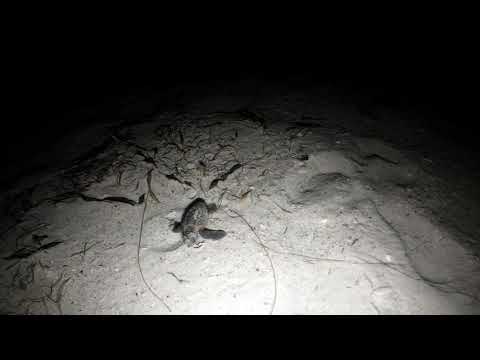Few sights in nature rival the magic of sea turtle hatchlings emerging from sandy nests and scrambling toward the ocean.
These tiny reptiles, just 2-3 centimeters long, somehow know to hatch from leathery shells under cover of darkness to reach the sea. Peak loggerhead turtle hatching activity has been precisely recorded to occur between the nighttime hours of 9 pm and 5 am on beaches from Florida to the Carolinas.
Why do these hatchlings choose to emerge en masse deep in the dead of night? Read on to explore how loggerheads and other sea turtle species likely use combinations of temperature cues, predator avoidance, and light orientation to optimize survival by timing dramatic mass nest escapes to shadowy hours after moonrise.

We will also overview real scientific hatching logs and reasons rare daytime hatching events may anomalously occur. Let’s delve into the amazing nocturnal world of sea turtles!
What time of night do sea turtles hatch?
Sea turtles begin the hatching process after dark, usually between 9 pm and midnight. After slowly piping out of eggshells over 12-48 hours, a mass eruption of 2-3 cm hatchlings emerges between 9 pm and 5 am. Peak activity hits between 10 pm and 2 am for most loggerheads.
Green and leatherback hatchings also occur within this late nighttime window. The darkness provides cover and orientation cues as thousands of tiny flippers start scrambling furiously landward.
By dawn, the nest excavation is complete, leaving behind empty shells and stragglers to bake under the rising sun. So the majority of coastal sea turtle hatching drama across all species unfolds during late night hours between 9 pm and 5 am!
What are the Stages of Turtle Nesting?
Before delving into hatching times, it’s important to understand the full sea turtle nesting process. There are several key stages:
- Female turtles haul themselves onto beaches and dig nests in the sand to lay their eggs, usually at night. Nest digging can take 1-2 hours!
- The turtles deposit dozens or even hundreds of tiny white eggs into each nest, depending on the species. Leatherbacks can lay up to 80 fertilized eggs the size of billiard balls in one session.
When Does Hatching Occur?
Sea turtle eggs incubate underground for 6-12 weeks before hatching, depending on factors like temperature and humidity. Generally, hatching occurs in coordination with the time the mother turtle laid the eggs.
So if an adult sea turtle hauled onto the beach at 9 PM and finished laying her eggs by midnight, the hatchlings would likely emerge around midnight 6-12 weeks later. Turtles seem to have an internal biological clock that helps coordinate synchronous mass hatchings.
Why Do Most Hatchings Occur at Night?
The vast majority of sea turtle nests – often over 90% – hatch at night. There are several adaptive reasons behind this:
- Avoiding daytime heat – Hatching and crawling during the coolest parts of the 24 hour cycle reduces overheating risks.
- Predator avoidance – Dim light makes hatchlings harder for predators like birds and crabs to see.
- Bright horizon finding – Hatchlings use dim ambient light from the open horizon to orient and crawl toward the sea.
So in essence, darkness provides the ideal blend of cool, safety, and sea-finding light cues.
When Are Peak Hatching Hours?
While any dark hour may bring hatchings, research shows sea turtle embryos seem to purposefully wait until deeper nighttime hours for peak emergence activity:
9 PM-5 AM – The majority of loggerhead turtle hatching and emergence events occur during these core late night hours when beaches are very dark.
One Florida study found up to 98% of over 400 hatching events happened within this 4-hour period, regardless of geographical nest location or date through the season.
So while staggered hatchings may persist for hours, true peak hatching is concentrated in the dead of night between 10 PM-2 AM.
Can Daytime Hatchings Occur?
While rare, some interesting daytime hatching events have been recorded. Certain situations can trigger abnormal early morning or afternoon nest emergences:
- Extreme heat – Excessive egg clutch temperatures may spur premature escape efforts.
- Tropical storms – Daytime nest escapes have occurred just prior to storm strikes.
- Disturbed nests – Human activity or wildlife digging can lead to daylight hatchings.
That said, daytime hatch success is poor. Without darkness, hatchlings struggle to properly navigate to the sea and have much higher predation rates. So emergency daylight hatchings demonstrate the supreme importance of optimal nighttime hatching!
The Hatching Process
When ready, hatchlings begin nibbling their way out of leathery shells with an “egg tooth” temporary beak. This takes 12-48 hours. Finally, they erupt upwards as a group when a solid column of siblings forms.
The 2-3cm babies may rest under the surface for hours to absorb egg yolks. Then they begin crawling, directed by moonlight or bioluminescence reflecting off the lighter ocean. The patter of countless flippers moving as one is unforgettable!
The scramble to the sea is urgent – hatchlings have just a narrow 48-hour window to make their getaway before running out of energy reserves. It’s crucial they emerge under cover of nighttime darkness for maximum speed and safety.
Peak Hatching Times for Common Sea Turtle Species
| Sea Turtle Species | Peak Hatching Hours |
|---|---|
| Loggerhead Sea Turtle | 10 pm – 2 am |
| Green Sea Turtle | 12 am – 2 am |
| Leatherback Sea Turtle | 11 pm – 1 am |
| Hawksbill Sea Turtle | Midnight |

Conclusion
Few wildlife moments compare to witnessing a sea turtle hatching event firsthand. Learning when peak hatchings occur at night helps observers understand these amazing natural cycles.
As more nests emerge deep under cover of darkness in the coming years, the future of sea turtle conservation looks brighter!

